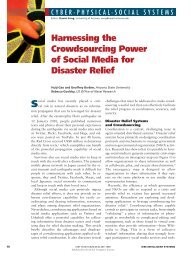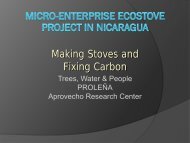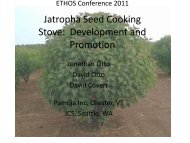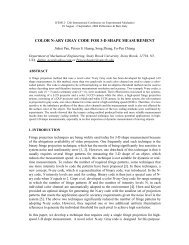New Rocket Stove Designs For Central And Southern
New Rocket Stove Designs For Central And Southern
New Rocket Stove Designs For Central And Southern
Create successful ePaper yourself
Turn your PDF publications into a flip-book with our unique Google optimized e-Paper software.
<strong>New</strong> <strong>Rocket</strong> <strong>Stove</strong> <strong>Designs</strong> for<br />
<strong>Central</strong> and <strong>Southern</strong> Africa<br />
PETER SCOTT<br />
JAYME VINEYARD<br />
APROVECHO /GTZ<br />
apropeter@hotmail.com
Our approach in Africa<br />
Principles, not one particular stove<br />
Adapt to cooking culture – easier to change the<br />
stove than change the cook<br />
Goal of zero training and zero maintenance<br />
Affordable<br />
durable<br />
commercial viability<br />
Target communities that use a mixture of<br />
charcoal and wood if possible
200 kg of wood for<br />
17 kg of bread<br />
<strong>Rocket</strong> Bread Oven<br />
5 kg of wood for 17<br />
kg of bread
Existing Institutional stoves<br />
Expensive ($700-1000)<br />
High maintenance<br />
(chimney)<br />
(<strong>Central</strong> Africa)
<strong>Rocket</strong> 100-300L (Uganda)<br />
100Litre WBT<br />
PHU Efficiency<br />
49% without<br />
chimney<br />
Boiled 75 Litres of<br />
water in 52 min (no<br />
lid) approx 6 kgs of<br />
wood<br />
100Litre WBT<br />
<br />
36% with chimney
Portable <strong>Rocket</strong> 100-300 L<br />
(Uganda)<br />
Existing Markets for<br />
institutional stove<br />
Material costs approx<br />
US$100<br />
Pre-existing stoves<br />
already sell for approx<br />
US$3-500
Improved Lorena (Uganda)<br />
4 types of new Lorena<br />
stoves (pumice,<br />
sawdust, tile/wood<br />
ash, vermiculite<br />
Improved heat transfer<br />
<strong>Rocket</strong> combustion<br />
elbow<br />
Efficiencies: 26-32% for<br />
2 pots
Household stoves (Uganda)<br />
Average 8 person<br />
Urban/periurban<br />
household spend<br />
US$.50-1 for wood<br />
and US$.50-2 for<br />
charcoal<br />
<strong>Stove</strong>s will retail for<br />
US$10-20
Nkokonono Household (Lesotho)<br />
Multiple pot sizes 1-6<br />
Material costs about<br />
US$10<br />
Retail US$15-30
Institutional stoves for WFP (Lesotho)<br />
No Food Without Fuel Project<br />
Boiled 15 litres of water in<br />
18 min(with lid)<br />
Retail US$100-150<br />
Cement vermiculite<br />
combustion chamber<br />
Produced by a partnership<br />
between AT Section of<br />
Local Government, private<br />
enterprise, GTZ and WFP
Nkokonono Poloko 20
Institutional stoves for WFP (Mozambique)<br />
Fagao MangiMangi<br />
Gap‘A’<br />
Gap ‘C’<br />
One school with 160<br />
day students spends<br />
between 450-<br />
US$2500 per year<br />
•Material Cost approx<br />
$US 35 Retail US$80<br />
To calculate gap A ( between the top of the combustion gap A = Area of feed chamber<br />
chamber and the pot) Perimeter of feed chamber<br />
To calculate gap B ( between the pot and the gap B = Area of feed chamber<br />
outer edge of the combustion chamber) Perimeter of outer feed chamber =<br />
[(D+10 cm] *3.14)<br />
•Preliminary test<br />
To calculate gap C (under the outer edge of the pot gap C = Area of feed chamber<br />
and the stove body) Circumference Pot<br />
To calculate gap D (between the sides of the pot gap D = gap C and the stove body)<br />
* 0.75<br />
Gap ‘D’<br />
Gap‘ B’<br />
•2kgs of wood to boil<br />
40Litres in 30 min
Cement<br />
Vermiculite<br />
bricks in<br />
Mozambique<br />
Basic recipe<br />
1 liter Vermiculite plus<br />
170 g Cement mix dry<br />
then add<br />
290 g Water<br />
Don’t tamp , dry for 10<br />
days
Sawdust/clay<br />
bricks in<br />
Mozambique<br />
Clay<br />
Bag 2<br />
Sawdust water Pre fire<br />
weight<br />
Post fire<br />
weight<br />
volume Actual<br />
density<br />
700 500 600 625g 973cc .64<br />
g/cc<br />
Post Remarks not could be more resistant to abrasion
<strong>Stove</strong>s in Hillcrest South Africa
The <strong>Rocket</strong> <strong>Stove</strong> Principle<br />
Maximizing combustion and heat<br />
transfer efficiency
Aprovecho Research Center<br />
Appropriate <strong>New</strong> Technology <strong>Rocket</strong> <strong>Stove</strong> <strong>Designs</strong> Research for Center<br />
<strong>Central</strong> and <strong>Southern</strong> Africa<br />
based in Oregon, USA<br />
Building stoves since 1976<br />
We offer technical support for stoves<br />
projects around the world.<br />
Interested in creating links with other stove<br />
designers to improve local designs
The Lorena <strong>Stove</strong><br />
Benefits<br />
50% wood savings<br />
Chimney<br />
Enclosed firebox<br />
Owner built<br />
BUT<br />
In certain cases used<br />
significantly more wood<br />
than a traditional 3 stone<br />
fires
Simplified stove theory<br />
Wood doesn’t burn<br />
Wood gets hot and releases volatile gases that then<br />
combust<br />
<strong>For</strong> this to happen we nee to have sufficient temperature<br />
If wood is heated to 650 degrees Celsius (and sufficient<br />
oxygen is mixed with the volatile gases) the result is<br />
complete combustion . The products of clean<br />
combustion are CO2 , water vapour and heat.<br />
A lot of heat , roughly speaking , dry wood has half the<br />
energy per kg as gasoline, if it is utilized<br />
Smoke is wasted energy
What are limiting factors to high temperatures ?<br />
Challenge # 1<br />
Cool stove body<br />
Cool earth<br />
the body of the stove or of the<br />
earth robs heat from the fire<br />
which lowers combustion<br />
temperatures… which<br />
decreases efficiency…and<br />
increases smoke<br />
Solution?<br />
Insulate the stove with low<br />
mass, heat resistant materials<br />
in order to keep the fire as hot<br />
as possible<br />
Remember mass is the<br />
opposite of insulation<br />
Effective stove insulators are<br />
pumice , vermiculite, and wood<br />
ash<br />
Dense things such as<br />
earth,sand, cement, water and<br />
cast iron are poor insulators
Maximizing combustion efficiency<br />
Challenge #2<br />
Cool wood<br />
which lowers combustion<br />
temperatures…which<br />
decreases efficiency…<strong>And</strong><br />
increases smoke<br />
Solution?<br />
Meter the fuel!<br />
Use small sticks whenever<br />
possible<br />
Maximize the surface area of the<br />
wood exposed to coals<br />
Heat only the fuel that is burning<br />
• Burn the tips of sticks only as<br />
they enter the combustion<br />
chamber
Maximizing combustion efficiency<br />
Challenge # 3<br />
Cool air/ Too much<br />
air<br />
which lowers combustion<br />
temperatures… which<br />
decreases efficiency…<strong>And</strong><br />
increases smoke<br />
Note: an open fire can draw 20<br />
times more than is required for<br />
stochiometric (chemically<br />
ideal) combustion<br />
Solution ?<br />
Do not allow too much or<br />
too little air to enter the<br />
combustion chamber.<br />
there should be the<br />
minimum excess of air<br />
supporting clean burning.
Maximizing combustion efficiency<br />
Challenge # 4<br />
Cool cooking pot<br />
The cooking pot is<br />
generally no more<br />
than a 100 –200<br />
degrees Celsius<br />
Flames touching the<br />
pot?<br />
Soot and smoke!<br />
Solution?<br />
Elevate the pot above the<br />
height of the flames<br />
This creates an internal<br />
‘chimney’ which<br />
increases draft<br />
<strong>And</strong> gives time for<br />
improved air/ fuel mixing
The Dr Winiarski <strong>Rocket</strong> <strong>Stove</strong><br />
Insulated low mass<br />
combustion chamber<br />
Internal shelf allows sticks to<br />
form a grate. Stick/air/stick/air<br />
Small amount of high velocity<br />
air is drawn under the coals<br />
and the wood ‘grate’ which<br />
improves air to fuel mixture<br />
<strong>Stove</strong> power is controlled by<br />
regulating the fuel supply not<br />
the air intake<br />
Horizontal feed chamber is<br />
convenient<br />
Since its invention in 1984<br />
over 15,000 rocket stoves<br />
have been built
Optimising heat transfer<br />
<strong>For</strong>ce hot flue gases<br />
around pot<br />
Maximize velocity of<br />
hot flue gases to<br />
disturb boundary layer<br />
Maximize Delta T<br />
<br />
With a heat exchanger,<br />
overall efficiency can be<br />
improved by 50% or more
<strong>Rocket</strong> stove heat exchanger/skirt<br />
Minimize the gap<br />
between the skirt and the<br />
pot while maintaining the<br />
cross sectional area of<br />
the combustion chamber<br />
( for average size pots<br />
1cm is good rule of<br />
thumb)<br />
Make it adjustable to<br />
accommodate different<br />
size pots<br />
Make it as tall as feasibly<br />
possible
Material options (clay tiles)<br />
The Baldosa clay tile<br />
Very durable: 4 years of<br />
success in <strong>Central</strong> America<br />
Inexpensive: less than 1US$<br />
per combustion chamber<br />
Not monolithic: individual parts<br />
‘float’ so they can withstand<br />
greater thermal shock.<br />
Low mass: needs insulation<br />
Can be cut from pre-existing<br />
tiles or made from moulds
Material options VIC (vernacular Insulated Ceramic)<br />
The six brick stove<br />
Can be made from<br />
Clay/pumice<br />
Clay/pearlite or<br />
Clay/vermiculite<br />
OR with a clay/cement and an<br />
organic material , such as fine<br />
sawdust or ground coffee<br />
husks<br />
These bricks can then be<br />
placed in a metal stove body<br />
or in a mud stove<br />
Very cheap/not monolithic
Material options (metal)<br />
<strong>Rocket</strong> <strong>Stove</strong>s can be<br />
made with steel drums,<br />
3mm mild steel, stainless<br />
steel, 3CR12.<br />
Life expectancy 1- 4<br />
years<br />
Shown here is a Rwandan<br />
refugee camp stove<br />
made from used cans<br />
(used to deliver food<br />
supplies to the camp)<br />
5,000 were made in 1994
Emission data<br />
(UC Berkeley/Aprovecho emission test in Nicaragua 2000)<br />
Table 4. Emission factors in grams per MJ-delivered.<br />
<strong>Stove</strong> test Thermal Emission Factors (g pollutant per MJ delivered, g/MJ-del)<br />
Efficiency CO2 CO CH4 TNMHC<br />
Eco<strong>Stove</strong> #2 13.98 % 537 8.0 0.13 0.29<br />
Eco<strong>Stove</strong> #4 21.01% 352 2.9 0.026 0.091<br />
<strong>Rocket</strong> #1 33.67 % 220 3.2 0.063 0.094<br />
<strong>Rocket</strong> #2 28.89 % 263 5.7 0.037 0.097<br />
Three-stone fire 10.29 % 589 18 1.0 0.88
Guatemalan single pot rocket<br />
Materials<br />
pumice,<br />
baldosa tiles<br />
galvanized corrugated<br />
skirt<br />
1/3 of a 200 litre drum<br />
Cost approx. 7US$ for<br />
materials<br />
Efficiency 35%<br />
80% Reduction in fuel<br />
consumption
Double Burner <strong>Rocket</strong> <strong>Stove</strong> (SA)<br />
Materials<br />
Two thirds of metal drum<br />
10 kg Vermiculite<br />
Mild steel elbow<br />
Can be adapted to hold<br />
size 1-8 cast iron pot<br />
Can bake w/25 litre drum<br />
Material cost :w/donated<br />
drum 95R<br />
Efficiency: 25% per<br />
elbow
<strong>Rocket</strong> stoves with chimneys<br />
Decrease the gap between the heat exchanger and<br />
stove body (compared to un-vented stove<br />
<strong>For</strong>ce heat to rub against heat exchanger<br />
Insulate all parts of the stove body<br />
Keep exit temperatures low (around 180)<br />
Remember that chimneys use heat to operate (steal<br />
approx 1/3 of heat from stove or room) clean burning<br />
stoves have less of a need for an external chimney
Helps/Aprovecho Cement stove<br />
Materials<br />
<strong>Stove</strong> body made from 3<br />
independent 2.5 cm thick<br />
cement walls (made w/<br />
portable fibreglass moulds)<br />
Baldosa combustion chamber<br />
Removable rings<br />
Reduces fuel consumption by<br />
65%<br />
1,000 made in last 2<br />
years
Sunken pot Eco <strong>Stove</strong> (SA)<br />
2 models: one for flat<br />
bottomed pots and one for<br />
round bottom. Both bake<br />
bread in about 25 min.<br />
<strong>Stove</strong> body: galvanized<br />
steel<br />
Combustion chamber:<br />
3CR12<br />
Material cost 300R<br />
Efficiency (Stainless Steel<br />
version) 34%
Aprovecho/Prolena Ecostove<br />
Made with 2 piece<br />
refractory ceramic<br />
combustion chamber<br />
Insulated w/Pumice<br />
Bakes bread<br />
Ideal for flat bottomed<br />
pots (I.e Nicaragua or<br />
Zimbabwe<br />
Efficiency 22%<br />
Wood savings 40-75%<br />
depending on usage<br />
Cost 65US$
Eco<strong>Stove</strong>/Estufa Justa<br />
Made with brick stove<br />
body and baldosa<br />
combustion chamber<br />
Over 3,000 made in<br />
<strong>Central</strong> America<br />
Cost approx 45US$<br />
Efficiency 22% with<br />
three pots<br />
3,000 made in the last 3<br />
years
Wood fired cocoa dryer (Nica)<br />
In two tests of 125<br />
pounds of apples and<br />
tomatoes, the dryer used<br />
one pound of wood to dry<br />
one pound of wet<br />
produce.The dryer uses<br />
about 10 pounds of wood<br />
per hour to keep at 130F<br />
a space 4' by 10' by 4'<br />
full of screens of sliced<br />
fruit, etc. Full of cacao is<br />
about 500 pounds.
Other Aprovecho <strong>Designs</strong><br />
We also have designs<br />
for:<br />
30-200 liter institutional<br />
stoves<br />
garbage incinerators<br />
community bread ovens<br />
Space and water heating<br />
stoves<br />
Chinese wok stoves
The ETHOS Network<br />
Our university partners play a key<br />
role in stove development<br />
ISU focuses on virtual reality<br />
modelling<br />
CSU and NOAA perform<br />
emissions testing<br />
<strong>And</strong> University of Dayton<br />
performs material testing.<br />
UC Berkeley and NOAA provide<br />
emission testing<br />
This research is then incorporated<br />
into stove designs that are<br />
disseminated by our NGO<br />
partners such as Helps Int’l ,<br />
Trees Water and People, and<br />
Winrock Int’l
ETHOS Research<br />
Students at University of<br />
Dayton Perform<br />
compression,<br />
thermal shock and<br />
3-point bending<br />
tests on on our 6<br />
Brick VIC stove We<br />
invite you to join our<br />
network to make use of this<br />
amazing volunteer program
Other useful contact sites<br />
http://www.repp.org/discussiongroups/resources/stoves/Smith/Prime<br />
r/Primer.html<br />
http://www.repp.org/discussiongroups resources/stoves/#Dean_Still<br />
MAKING LIGHT WEIGHT REFRACTORY CERAMIC FROM<br />
PERLITE AND CLAY Damon Ogle Jan 13, 2003<br />
<strong>Rocket</strong> <strong>Stove</strong>s - Controlling Draft, August 17, 2002<br />
Ceramic <strong>Stove</strong> Tests Aprovecho July 2002<br />
<strong>Rocket</strong> <strong>Stove</strong> User Guide (pdf 40 k)<br />
<strong>Rocket</strong> <strong>Stove</strong> Design Guide (pdf 100kb<br />
http://faculty.washington.edu/~yark/stoves.html
Way <strong>For</strong>ward<br />
Introduce the 6 Brick VIC <strong>Stove</strong> to Lesotho<br />
and Uganda.<br />
Build a portable (metal clad) and a fixed<br />
mud version<br />
Link with Shell Foundation/UC Berkeley<br />
testing protocol project<br />
????? Pilot projects for commercializing<br />
the <strong>Rocket</strong> in Africa
NCE

















